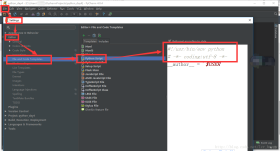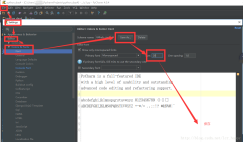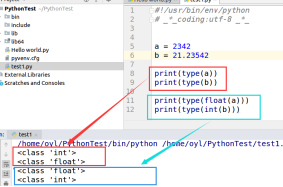1、pycharm使用前的一些简单设置
1、注释模板设置
为了不由每次新建一个py文件都输入下面注释可如图设置:
#!/usr/bin/env/python
# _*_coding:utf-8 _*_
具体设置为: 打开file->settings->Editor->file and code template->python script,然后在模板内输入上面两行代码保存即可.

2、文字大小和颜色和风格
打开file->settings->Editor->Colors & Fonts
file-settings-appearance-theme-选择自己需要的风格
先单击save as,然后在size里面输入适合的大小,根据自身需要设置

2、 基本数据类型
1、六个标准的数据类型:
- Numbers(数字)
- String(字符串)
- List(列表)
- Tuple(元组)
- Sets(集合)
- Dictionaries(字典)
2、Numbers(数字)
Python 支持三种不同的数值类型:整型(int)、浮点型(float)、复数(complex)
复数由实数部分和虚数部分构成,可以用a + bj,或者complex(a,b)表示, 复数的实部a和虚部b都是浮点型
python数字类型相互转换
int(x) 将x转换为一个整数。
float(x) 将x转换到一个浮点数。
complex(x) 将x转换到一个复数,实数部分为 x,虚数部分为 0。complex(x, y) 将 x 和 y 转换到一个复数,实数部分为 x,虚数部分为 y。x 和 y 是数字表达式。
我们可以用type来判断当前数据类型
>> a =222 >>> b =21.3443 >>> print(type(a)) <class 'int'> >>> print(type(b)) <class 'float'> >>>

3、String(字符串)
字符串表示非常简单,一对双引号即可
str1 = "Hello world" str2 = "I love python"
字符串本质上就是由多个字符组成的,因此程序允许通过索引来操作字符
1、首先我们可以通过print打印出字符串,再通过type查看它的数据类型,
str1 = "Hello world" str2 = "I love python" print(str1) print(type(str1)) print(str2) print(type(str2))
结果:
Hello world <class 'str'> I love python <class 'str'>
2、访问字符串中的值和分片
str1 = "Helloworld" str2 = "Ilovepython" print("str1[0]:",str1[0])#得到第一个字母 print("str2[3:6]:",str2[3:6])#得到第三到六的字母
str = "string" str[1:3] # "tr",获取从偏移为1到偏移为3的字符串,不包括偏移为3的字符 str[1:] # "tring",获取从偏移为1到最后的一个字符,不包括最后一个字符 str[:3] #"str",获取从偏移为0的字符一直到偏移为3的字符串,不包括偏移为3的字符串 str[:-1] #strin",获取从偏移为0的字符一直到最后一个字符(不包括最后一个字符串) str[:] #"string",获取字符串从开始到结尾的所有元素 str[-3:-1] #"in",获取偏移为-3到偏移为-1的字符,不包括偏移为-1的字符 str[::-1] # "gnirts",反转输出
3、字符串的方法
replace()方法:replace() 方法把字符串中的 old(旧字符串) 替换成 new(新字符串),如果指定第三个参数max,则替换不超过 max 次
str = "This is A Test" print(str.replace("is", "was")) # Thwas was A Test" print(str.replace("is", "was", 1)) #Thwas is A Test
find()方法:find() 方法检测字符串中是否包含子字符串 str ,如果指定 beg(开始) 和 end(结束) 范围,则检查是否包含在指定范围内,如果指定范围内如果包含指定索引值,返回的是索引值在字符串中的起始位置。如果不包含索引值,返回-1
str.find(str,beg = 0, end = len(str))
str -- 指定检索的字符串
beg -- 开始索引,默认为0。
end -- 结束索引,默认为字符串的长度。
返回值:
如果包含子字符串返回开始的索引值,否则返回-1
str1 = "python web: www.python.org" str2 = "we" print(str1.find(str2)) # 7 print(str1.find(str2, 3)) # 7 print(str1.find(str2, 8)) # -1